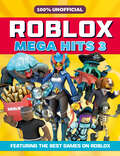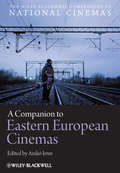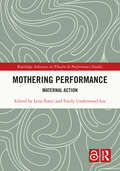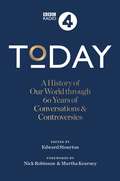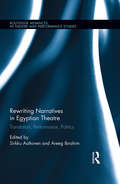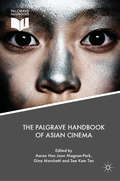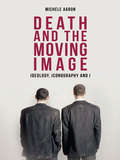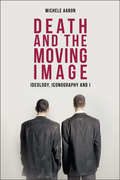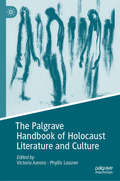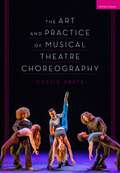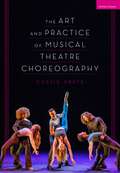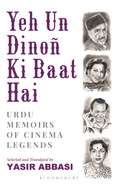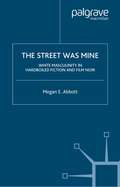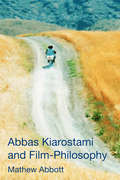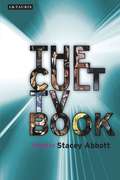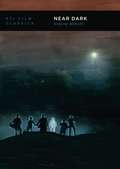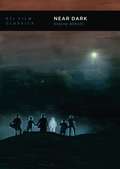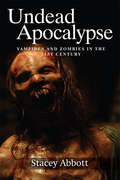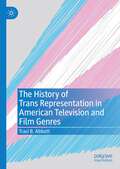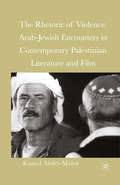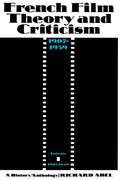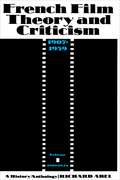- Table View
- List View
100% Unofficial Roblox Mega Hits 3
by 100% UnofficialOVER 15 MORE OF ROBLOX’S BEST GAMES INSIDE FOR YOU TO EXPLORE
A Companion to Eastern European Cinemas (Wiley Blackwell Companions to National Cinemas)
by Anik 243 Imre Anikó ImreA Companion to Eastern European Cinemas showcases twenty-five essays written by established and emerging film scholars that trace the history of Eastern European cinemas and offer an up-to-date assessment of post-socialist film cultures. Showcases critical historical work and up-to-date assessments of post-socialist film cultures Features consideration of lesser known areas of study, such as Albanian and Baltic cinemas, popular genre films, cross-national distribution and aesthetics, animation and documentary Places the cinemas of the region in a European and global context Resists the Cold War classification of Eastern European cinemas as “other” art cinemas by reconnecting them with the main circulation of film studies Includes discussion of such films as Taxidermia, El Perro Negro, 12:08 East of Bucharest Big Tõll, and Breakfast on the Grass and explores the work of directors including Tamás Almási, Walerian Borowczyk, Roman Polanski, Jerzy Skolimowski, Andrzej ¯u³awski, and Karel Vachek amongst many others
Mothering Performance: Maternal Action (Routledge Advances in Theatre & Performance Studies)
by Lena Simi 263 Emily Underwood-LeeMothering Performance is a combination of scholarly essays and creative responses which focus on maternal performance and its applications from a variety of interdisciplinary perspectives. This collection extends the concept and action of ‘performance’ and connects it to the idea of ‘mothering’ as activity. Mothering, as a form of doing, is a site of never-ending political and personal production; it is situated in a specific place, and it is undertaken by specific bodies, marked by experience and context. The authors explore the potential of a maternal sensibility to move us towards maternal action that is explicitly political, ethical, and in relation to our others. Presented in three sections, Exchange, Practice, and Solidarity, the book includes international contributions from scholars and artists covering topics including ecology, migration, race, class, history, incarceration, mental health, domestic violence, intergenerational exchange, childcare, and peacebuilding. The collection gathers diverse maternal performance practices and methodologies which address aesthetics, dramaturgy, activism, pregnancy, everyday mothering, and menopause. The book is a great read for artists, maternal health and care professionals, and scholars. Researchers with an interest in feminist performance and motherhood, within the disciplines of performance studies, maternal studies, and women’s studies, and all those who wish to gain a deeper understanding of maternal experience, will find much of interest.
Today: A History of our World through 60 years of Conversations & Controversies
by BBC Radio 4Edited by Edward StourtonForewords by Nick Robinson & Martha KearneyWith an introduction by Sarah Sands, editor of the Today programme.Today marks six decades of BBC Radio 4's Today programme with sixty world changing stories as they were broadcast. Covering war, rebellion and political transformation, to significant changes in culture, society, and the scientific world, the first ever book from the Today programme explores events as they happened, and how they changed the world around us. From the fall of the Berlin Wall and the anti-apartheid movement to 9/11 and the Rise of Islamic State, from the Rushdie affair to the emergence of Brit Art and from space exploration to the tomorrow's world of artificial intelligence and machine learning. In an era of fake news, echo chambers and new fault lines in global politics, millions of listeners turn to Today each morning for the latest headlines and to help them make sense of the world around them. Today reflects six decades of the sound of history being made - live on air.
Rewriting Narratives in Egyptian Theatre: Translation, Performance, Politics (Routledge Advances in Theatre & Performance Studies)
by Sirkku Aaltonen Areeg IbrahimThis study of Egyptian theatre and its narrative construction explores the ways representations of Egypt are created of and within theatrical means, from the 19th century to the present day. Essays address the narratives that structure theatrical, textual, and performative representations and the ways the rewriting process has varied in different contexts and at different times. Drawing on concepts from Theatre and Performance Studies, Translation Studies, Cultural Studies, Postcolonial Studies, and Diaspora Studies, scholars and practitioners from Egypt and the West enter into dialogue with one another, expanding understanding of the different fields. The articles focus on the ways theatre texts and performances change (are rewritten) when crossing borders between different worlds. The concept of rewriting is seen to include translation, transformation, and reconstruction, and the different borders may be cultural and national, between languages and dramaturgies, or borders that are present in people’s everyday lives. Essays consider how rewritings and performances cross borders from one culture, nation, country, and language to another. They also study the process of rewriting, the resulting representations of foreign plays on stage, and representations of the Egyptian revolution on stage and in Tahrir Square. This assessment of the relationship between theatre practices, exchanges, and rewritings in Egyptian theatre brings vital coverage to an undervisited area and will be of interest to developments in theatre translation and beyond.
Rewriting Narratives in Egyptian Theatre: Translation, Performance, Politics (Routledge Advances in Theatre & Performance Studies)
by Sirkku Aaltonen Areeg IbrahimThis study of Egyptian theatre and its narrative construction explores the ways representations of Egypt are created of and within theatrical means, from the 19th century to the present day. Essays address the narratives that structure theatrical, textual, and performative representations and the ways the rewriting process has varied in different contexts and at different times. Drawing on concepts from Theatre and Performance Studies, Translation Studies, Cultural Studies, Postcolonial Studies, and Diaspora Studies, scholars and practitioners from Egypt and the West enter into dialogue with one another, expanding understanding of the different fields. The articles focus on the ways theatre texts and performances change (are rewritten) when crossing borders between different worlds. The concept of rewriting is seen to include translation, transformation, and reconstruction, and the different borders may be cultural and national, between languages and dramaturgies, or borders that are present in people’s everyday lives. Essays consider how rewritings and performances cross borders from one culture, nation, country, and language to another. They also study the process of rewriting, the resulting representations of foreign plays on stage, and representations of the Egyptian revolution on stage and in Tahrir Square. This assessment of the relationship between theatre practices, exchanges, and rewritings in Egyptian theatre brings vital coverage to an undervisited area and will be of interest to developments in theatre translation and beyond.
The Palgrave Handbook of Asian Cinema
by Aaron Han Joon Magnan-Park Gina Marchetti See Kam TanThis collection offers new approaches to theorizing Asian film in relation to the history, culture, geopolitics and economics of the continent. Bringing together original essays written by established and emerging scholars, this anthology transcends the limitations of national borders to do justice to the diverse ways in which the cinema shapes Asia geographically and imaginatively in the world today. From the revival of the Silk Road as the “belt and road” of a rising China to historical ruminations on the legacy of colonialism across the continent, the authors argue that the category of “Asian cinema” from Turkey to the edges of the Pacific continues to play a vital role in cutting-edge film research. This handbook will serve as an essential guide for committed scholars, students, and all those interested in the past, present, and possible future of Asian cinema in the 21st century.
Death and the Moving Image: Ideology, Iconography and I
by Michele AaronDeath and the Moving Image examines the representation of death and dying in mainstream cinema from its earliest to its latest renditions to reveal the ambivalent place of death in twentieth and twenty-first century culture: the ongoing split between its over- and under-statement, between its cold, bodily, realities and its fantastical, transcendental and, most importantly, strategic depictions. Our screens are steeped in death’s dramatics: in spectacles of glorious sacrifice or bloody retribution, in the ecstasy of agony, but always in the promise of redemption. This book is about the staging of these dramatics in mainstream Western film and the discrepancies that fuel them and are, by return, fuelled by them. Exploring the impact of gender, race, nation or narration upon them, this groundbreaking study isolates how mainstream cinema works to bestow value upon certain lives, and specific socio-cultural identities, in a hierarchical and partisan way. Dedicated to the popular, to the political and ethical implications of mass culture’s themes and imperatives, Death and the Moving Image takes this culture to task for its mortal economies of expendability. Ultimately, it also disinters the capacity for film, and film criticism, to engage with life and vulnerability differently and even generatively.
Death and the Moving Image: Ideology, Iconography and I
by Michele AaronDeath and the Moving Image examines the representation of death and dying in mainstream cinema from its earliest to its latest renditions to reveal the ambivalent place of death in twentieth and twenty-first century culture: the ongoing split between its over- and under-statement, between its cold, bodily, realities and its fantastical, transcendental and, most importantly, strategic depictions. Our screens are steeped in death’s dramatics: in spectacles of glorious sacrifice or bloody retribution, in the ecstasy of agony, but always in the promise of redemption. This book is about the staging of these dramatics in mainstream Western film and the discrepancies that fuel them and are, by return, fuelled by them. Exploring the impact of gender, race, nation or narration upon them, this groundbreaking study isolates how mainstream cinema works to bestow value upon certain lives, and specific socio-cultural identities, in a hierarchical and partisan way. Dedicated to the popular, to the political and ethical implications of mass culture’s themes and imperatives, Death and the Moving Image takes this culture to task for its mortal economies of expendability. Ultimately, it also disinters the capacity for film, and film criticism, to engage with life and vulnerability differently and even generatively.
The Palgrave Handbook of Holocaust Literature and Culture
by Victoria Aarons Phyllis LassnerThe Palgrave Handbook of Holocaust Literature and Culture reflects current approaches to Holocaust literature that open up future thinking on Holocaust representation. The chapters consider diverse generational perspectives—survivor writing, second and third generation—and genres—memoirs, poetry, novels, graphic narratives, films, video-testimonies, and other forms of literary and cultural expression. In turn, these perspectives create interactions among generations, genres, temporalities, and cultural contexts. The volume also participates in the ongoing project of responding to and talking through moments of rupture and incompletion that represent an opportunity to contribute to the making of meaning through the continuation of narratives of the past. As such, the chapters in this volume pose options for reading Holocaust texts, offering openings for further discussion and exploration. The inquiring body of interpretive scholarship responding to the Shoah becomes itself a story, a narrative that materially extends our inquiry into that history.
The Art and Practice of Musical Theatre Choreography
by Cassie AbateWhat does a musical theatre choreographer actually do? They just 'make up the steps', right? This book firstly debunks the misunderstandings around what musical theatre choreographers actually do, demonstrating their need to have an in-depth understanding of storytelling, music theory, performance practices and plot structure in order to create movement that enhances and enlivens the musical. Secondly, it equips the musical theatre choreographer with all the tools needed to create nuanced, informed and inspired movement for productions, through structured activities that build specific skills (such as 'notating the script' and 'scoring the score').Traditionally, this training has been something of a series of secrets, passed from mentor to apprentice. The author demystifies the process to make the previously undisclosed “tricks of the trade” accessible to all choreographers, everywhere. Covering the entire process of choreographing a musical from the first script reading to the final curtain call, this book makea case for the absolute integrity of the choreographer to any musical theatre production and sets out the theoretical principles of choreography alongside the practical application during every step of the production process.
The Art and Practice of Musical Theatre Choreography
by Cassie AbateWhat does a musical theatre choreographer actually do? They just 'make up the steps', right? This book firstly debunks the misunderstandings around what musical theatre choreographers actually do, demonstrating their need to have an in-depth understanding of storytelling, music theory, performance practices and plot structure in order to create movement that enhances and enlivens the musical. Secondly, it equips the musical theatre choreographer with all the tools needed to create nuanced, informed and inspired movement for productions, through structured activities that build specific skills (such as 'notating the script' and 'scoring the score').Traditionally, this training has been something of a series of secrets, passed from mentor to apprentice. The author demystifies the process to make the previously undisclosed “tricks of the trade” accessible to all choreographers, everywhere. Covering the entire process of choreographing a musical from the first script reading to the final curtain call, this book makea case for the absolute integrity of the choreographer to any musical theatre production and sets out the theoretical principles of choreography alongside the practical application during every step of the production process.
Yeh Un Dinoñ Ki Baat Hai: Urdu Memoirs of Cinema Legends
by Yasir AbbasiPeppered with heartfelt accounts and charming anecdotes, Urdu film magazines were in great favour with the public from the 1930s through the 1990s – a considerable period of seven decades. As Urdu got progressively marginalised in the later years, unfortunately these magazines were not archived for the most part, leading to their inevitable disappearance from popular imagination. Tracking down the lost publications, Yasir Abbasi followed leads – some futile, some fruitful – to obscure towns and people's homes in a last-ditch effort to save valuable records of Indian cinema. As challenging as it was to locate the faded issues and original texts, he managed to uncover and translate many fabulous memoirs covering a wide gamut of our favourite old artistes at their candid best. A gloom-laced piece on Meena Kumari by Nargis, a rollicking description by Raja Mehdi Ali Khan of an eventful evening with Manto (not to mention a mysterious woman and a house on fire), Jaidev writing about his chequered career, Balraj Sahni introspecting about the relevance of Hindi and Urdu in films – it's a rich mix of engrossing narratives brought back from oblivion.
The Street Was Mine: White Masculinity in Hardboiled Fiction and Film Noir
by M. AbbottThis book considers a recurrent figure in American literature: the solitary white man moving through urban space. The descendent of Nineteenth-century frontier and western heroes, the figure re-emerges in 1930-50s America as the 'tough guy'. The Street Was Mine looks to the tough guy in the works of hardboiled novelists Raymond Chandler ( The Big Sleep ) and James M. Cain ( Double Indemnity ) and their popular film noir adaptations. Focusing on the way he negotiates racial and gender 'otherness', this study argues that the tough guy embodies the promise of an impervious white masculinity amidst the turmoil of the Depression through the beginnings of the Cold War, closing with an analysis of Chester Himes, whose Harlem crime novels ( For Love of Imabelle ) unleash a ferocious revisionary critique of the tough guy tradition.
Abbas Kiarostami and Film-Philosophy
by Mathew AbbottMathew Abbott presents a powerful new film-philosophy through the cinema of Iranian director Abbas Kiarostami. Mathew Abbott argues that Kiarostami’s films carry out cinematic thinking: they do not just illustrate pre-existing philosophical ideas, but do real philosophical work. Crossing the divide between analytic and continental philosophy, he draws on Ludwig Wittgenstein, Stanley Cavell, John McDowell, Alice Crary, Noël Carroll, Giorgio Agamben, and Martin Heidegger, bringing out the thinking at work in Kiarostami’s most recent films: Taste of Cherry, The Wind Will Carry Us, ABC Africa, Ten, Five, Shirin, Certified Copy and Like Someone in Love.
Abbas Kiarostami and Film-Philosophy
by Mathew AbbottMathew Abbott presents a powerful new film-philosophy through the cinema of Iranian director Abbas Kiarostami. Mathew Abbott argues that Kiarostami’s films carry out cinematic thinking: they do not just illustrate pre-existing philosophical ideas, but do real philosophical work. Crossing the divide between analytic and continental philosophy, he draws on Ludwig Wittgenstein, Stanley Cavell, John McDowell, Alice Crary, Noël Carroll, Giorgio Agamben, and Martin Heidegger, bringing out the thinking at work in Kiarostami’s most recent films: Taste of Cherry, The Wind Will Carry Us, ABC Africa, Ten, Five, Shirin, Certified Copy and Like Someone in Love.
The Cult TV Book: From Star Trek To Dexter, New Approaches To Tv Outside The Box (Investigating Cult TV)
by Stacey AbbottCult TV is a very exciting area of contemporary television. The Cult TV Book is the companion reference to this TV phenomenon, whose shows push theboundaries and offer biting commentaries on society today.Cult TV is also changing. Where being cult used to mean being marginal with a small, loyal fan base, cult TV is now key to the television industry, fandom is global and online, cult status for a show is fostered by the networks, and cult series are noted for their spectacular special effects and sumptuous visual style.So, what is cult TV today? Leading scholars, writers and journalists redefine our understanding of cult TV, with new approaches to and case studies on: Cult TV aesthetics, History of cult TV, Cult TV & new media, The 'sub-cultural celebrity', Jane Espenson on how to write cult TV, Cult TV & the broadcast industry, Music, Innovation, Cult channels, Children's cult TV, Sex, Gender, Race, Cult audiences, Transgressive TV, Cult of cult TV, Nancy Holder on writing tie-ins, TV & Film Guide, Fan fiction, Battlestar Galactica, Buffy the Vampire Slayer, Doctor Who, The Avengers, The Prisoner, Quatermass, The Sopranos, Masters of Horror, The Twilight Zone, Twin Peaks, Grey's Anatomy, Bagpuss, South Park, The X Files, Da Ali G Show, Trailer Park Boys and Angel.Contributors: Stacey Abbott, Sergio Angelini, Jes Battis, Stan Beeler, Miles Booy, Simon Brown, Bronwen Calvert, Jane Espenson, Dick Fiddy, Lincoln Geraghty, Janet K. Halfyard, Matt Hills, Nancy Holder, Catherine Johnson, Lorna Jowett, Roz Kaveney, Roberta Pearson, Denzell Richards, HillaryRobson, David Simmons, Sharon Sutherland, Paul Sutton, Sarah Swan, Donato Totaro, Rhonda V. Wilcox, Tat Wood
Near Dark (BFI Film Classics)
by Stacey AbbottFirst released in 1987, Near Dark is a vampire film set in the contemporary American Midwest that tells the story of Caleb, a half-vampire trying to decide whether to embrace his vampire nature or return to his human family. The film, an early work of the now-established director Kathryn Bigelow, skilfully mixes genre conventions, combining gothic tropes with those of the Western, road movie and film noir, while also introducing elements of the outlaw romance genre.Stacey Abbott's study of the film addresses it as a genre hybrid that also challenges conventions of the vampire film. The vampires are morally ambiguous and undermine the class structures that have historically defined stories of the undead. These are not aristocrats but instead they capture the allure and horror of the disenfranchised and the underclass. As Abbott describes, Near Dark was crucial in consolidating Bigelow's standing as a director of significance at an early point in her career, not simply because of her visual art background, but because of the way in which she would from Near Dark onward re-envision other traditionally mainstream genres of filmmaking.
Near Dark (BFI Film Classics)
by Stacey AbbottFirst released in 1987, Near Dark is a vampire film set in the contemporary American Midwest that tells the story of Caleb, a half-vampire trying to decide whether to embrace his vampire nature or return to his human family. The film, an early work of the now-established director Kathryn Bigelow, skilfully mixes genre conventions, combining gothic tropes with those of the Western, road movie and film noir, while also introducing elements of the outlaw romance genre.Stacey Abbott's study of the film addresses it as a genre hybrid that also challenges conventions of the vampire film. The vampires are morally ambiguous and undermine the class structures that have historically defined stories of the undead. These are not aristocrats but instead they capture the allure and horror of the disenfranchised and the underclass. As Abbott describes, Near Dark was crucial in consolidating Bigelow's standing as a director of significance at an early point in her career, not simply because of her visual art background, but because of the way in which she would from Near Dark onward re-envision other traditionally mainstream genres of filmmaking.
Undead Apocalyse: Vampires and Zombies in the 21st Century (PDF)
by Stacey AbbottTwenty-first century film and television is overwhelmed with images of the undead. Vampires and zombies have often been seen as oppositional: one alluring, the other repellant; one seductive, the other infectious. With case studies of films like I Am Legend and 28 Days Later, as well as TV programmes like Angel and The Walking Dead, this book challenges these popular assumptions and reveals the increasing interconnection of undead genres. Exploring how the figure of the vampire has been infused with the language of science, disease and apocalypse, while the zombie text has increasingly been influenced by the trope of the ‘reluctant’ vampire, Stacey Abbott shows how both archetypes are actually two sides of the same undead coin. When considered together they present a dystopian, sometimes apocalyptic, vision of twenty-first century existence.
Undead Apocalyse: Vampires and Zombies in the 21st Century
by Stacey AbbottTwenty-first century film and television is overwhelmed with images of the undead. Vampires and zombies have often been seen as oppositional: one alluring, the other repellant; one seductive, the other infectious. With case studies of films like I Am Legend and 28 Days Later, as well as TV programmes like Angel and The Walking Dead, this book challenges these popular assumptions and reveals the increasing interconnection of undead genres. Exploring how the figure of the vampire has been infused with the language of science, disease and apocalypse, while the zombie text has increasingly been influenced by the trope of the ‘reluctant’ vampire, Stacey Abbott shows how both archetypes are actually two sides of the same undead coin. When considered together they present a dystopian, sometimes apocalyptic, vision of twenty-first century existence.
The History of Trans Representation in American Television and Film Genres
by Traci B. AbbottDue to the increase in transgender characters in scripted television and film in the 2010s, trans visibility has been presented as a relatively new phenomenon that has positively shifted the cis society’s acceptance of the trans community. This book counters this claim to assert that such representations actually present limited and harmful characterizations, as they have for decades. To do so, this book analyzes transgender narratives in scripted visual media from the 1960s to 2010s across a variety of genres, including independent and mainstream films and television dramatic series and sitcoms, judging not the veracity of such representations per se but dissecting their transphobia as a constant despite relevant shifts that have improved their veracity and variety. Already ingrained with their own ideological expectations, genres shift the framing of the trans character, particularly the relevance of their gender difference for cisgender characters and society. The popularity of trans characters within certain genres also provides a historical lineage that is examined against the progression of transgender rights activism and corresponding transphobic falsehoods, concluding that this popular medium continues to offer a limited and narrow conception of gender, the variability of the transgender experience, and the range of transgender identities.
The Rhetoric of Violence: Arab-Jewish Encounters in Contemporary Palestinian Literature and Film
by Kamal Abdel-MalekDespite the urgent need to develop understandings of the Palestinian-Israeli conflict in the light of the current situation in the Middle East, the role of violence and reconciliation in Palestinian and Israeli literature and film has received only brief treatment. This book is intended to fill that void; that is to explore how Israelis and Palestinians view and depict themselves and each other in situations that lead to either violence or reconciliation, and the ways in which both parties define themselves in relation to one another. The book examines selected Palestinian and Israeli literary works and a small number of films and their tacit assumptions about Israeli Jews. It will attempt to look at, among other questions a) is violence perceived as a means of empowerment, b) is there connection between imaginary violence in literature and actual violence, and what is the nature of the association between creative writers and violence? (eg. popular writer Ghassan Kanafani who is also a spokesman for the violent PFLP).
French Film Theory and Criticism, Volume 1: 1907-1929
by Richard AbelThese two volumes examine a significant but previously neglected moment in French cultural history: the emergence of French film theory and criticism before the essays of André Bazin. Richard Abel has devised an organizational scheme of six nearly symmetrical periods that serve to "bite into" the discursive flow of early French writing on the cinema. Each of the periods is discussed in a separate and extensive historical introduction, with convincing explications of the various concepts current at the time. In each instance, Abel goes on to provide a complementary anthology of selected texts in translation. Amounting to a portable archive, these anthologies make available a rich selection of nearly one hundred and fifty important texts, most of them never before published in English.
French Film Theory and Criticism, Volume 1: A History/Anthology, 1907-1939. Volume 1: 1907-1929
by Richard AbelThese two volumes examine a significant but previously neglected moment in French cultural history: the emergence of French film theory and criticism before the essays of André Bazin. Richard Abel has devised an organizational scheme of six nearly symmetrical periods that serve to "bite into" the discursive flow of early French writing on the cinema. Each of the periods is discussed in a separate and extensive historical introduction, with convincing explications of the various concepts current at the time. In each instance, Abel goes on to provide a complementary anthology of selected texts in translation. Amounting to a portable archive, these anthologies make available a rich selection of nearly one hundred and fifty important texts, most of them never before published in English.
